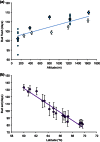Potential for evolutionary responses to climate change - evidence from tree populations
- PMID: 23505261
- PMCID: PMC3664019
- DOI: 10.1111/gcb.12181
Potential for evolutionary responses to climate change - evidence from tree populations
Abstract
Evolutionary responses are required for tree populations to be able to track climate change. Results of 250 years of common garden experiments show that most forest trees have evolved local adaptation, as evidenced by the adaptive differentiation of populations in quantitative traits, reflecting environmental conditions of population origins. On the basis of the patterns of quantitative variation for 19 adaptation-related traits studied in 59 tree species (mostly temperate and boreal species from the Northern hemisphere), we found that genetic differentiation between populations and clinal variation along environmental gradients were very common (respectively, 90% and 78% of cases). Thus, responding to climate change will likely require that the quantitative traits of populations again match their environments. We examine what kind of information is needed for evaluating the potential to respond, and what information is already available. We review the genetic models related to selection responses, and what is known currently about the genetic basis of the traits. We address special problems to be found at the range margins, and highlight the need for more modeling to understand specific issues at southern and northern margins. We need new common garden experiments for less known species. For extensively studied species, new experiments are needed outside the current ranges. Improving genomic information will allow better prediction of responses. Competitive and other interactions within species and interactions between species deserve more consideration. Despite the long generation times, the strong background in quantitative genetics and growing genomic resources make forest trees useful species for climate change research. The greatest adaptive response is expected when populations are large, have high genetic variability, selection is strong, and there is ecological opportunity for establishment of better adapted genotypes.
© 2013 Blackwell Publishing Ltd.
Figures




References
-
- Acevedo-Rodriguez R, Vargas-Hernandez JJ, Lopez-Upton J, Mendoza JV. Effect of geographic origin and nutrition on shoot prenology of Mexican Douglas-Fir (Pseudotsuga sp.) seedlings. Agrociencia. 2006;40:125–137.
-
- Aitken SN, Whitlock MC. Assisted gene flow to facilitate local adaptation to climate change. Annual Review of Ecology, Evolution, and Systematics. 2013;44 in press.
-
- Alberto F, Niort J, Derory J, Lepais O, Vitalis R, Galop D, Kremer A. Population differentiation of sessile oak at the altitudinal front of migration in the French Pyrenees. Molecular Ecology. 2010;19:2626–2639. - PubMed
-
- Alberto F, Bouffier L, Louvet JM, Lamy JB, Delzon S, Kremer A. Adaptive responses for seed and leaf phenology in natural populations of sessile oak along an altitudinal gradient. Journal of Evolutionary Biology. 2011;24:1442–1454. - PubMed
Publication types
MeSH terms
LinkOut - more resources
Full Text Sources
Other Literature Sources
Medical

